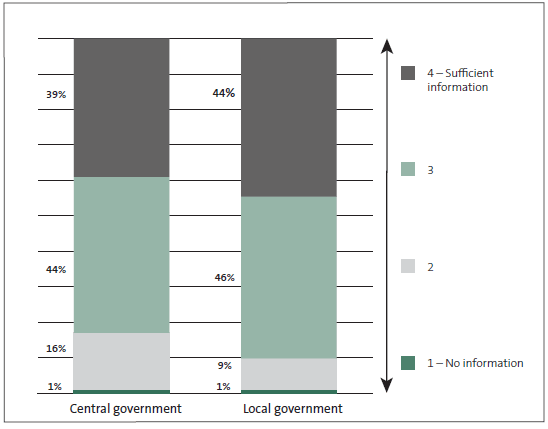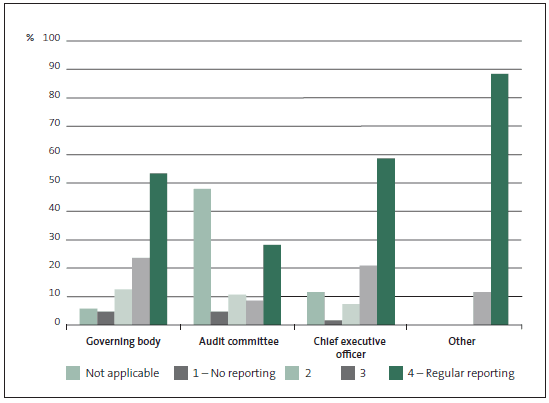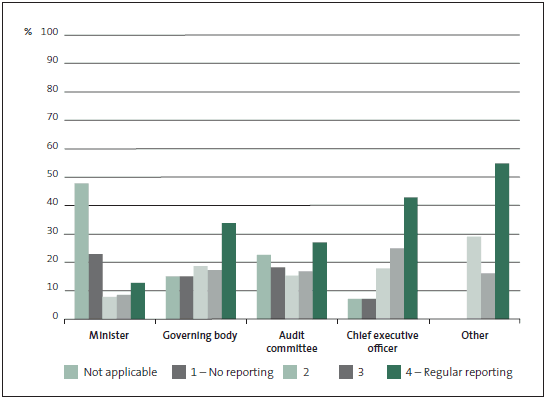Part 5: Asset condition information and reporting to decision-makers
5.1
In this Part, we discuss:
- how much information public entities hold about the condition of assets;
- the information needs of decision-makers; and
- how often entities report asset condition to decision-makers.
5.2
Regular reporting about asset condition to decision-makers ensures that they have the information required to make good decisions and that they are able to effectively manage the associated risks.
Information for decision-makers
5.3
International research and our experience tell us that assets are managed best when an appropriate integrated approach is taken, involving asset managers, engineers, valuers, planners, corporate finance staff, and strategic decision-makers. This ensures that the right people contribute information to the process.
5.4
The information provided must be in an understandable form, and received by decision-makers in a timely manner, to be of benefit. The information we obtained showed that overall reporting to decision-makers needs to be improved, as most decision-makers are not receiving information regularly. We expect that decision-makers should receive regular information on risks, expenditure (actual and budgeted), and performance indicators.
Available asset information
5.5
Good asset management relies on good information. Asset information can take many forms, from comprehensive asset management plans outlining future requirements for maintenance, renewal and enhancement, and recording services to more simple information.
5.6
We asked how much asset information each public entity records to ensure that assets are in a condition that supports continuing to provide services.
5.7
Our analysis of the information collected showed that local government entities have more asset condition information than central government entities, which suggests that there may be room for improvement in the information held by the central government entities. Local authorities having more asset condition information may be a result of the planning requirements that have developed in the last 20 years, such as financial prudence and long-term plans.
5.8
Figure 11 shows the average level of asset condition information available in local and central government.
5.9
Energy companies and state-owned enterprises are the entity types with the most information available. Crown research institutes and tertiary education institutions have the least.
Figure 11
How much information is held to ensure that all assets that provide services are kept in a condition that supports the continuing delivery of services

Regularity of asset condition reporting
5.10
On average, less than 60% of local government and 40% of central government decision-makers were receiving regular asset condition information. For some, more often in central government, asset conditions were reported rarely or not at all.
5.11
Audit committees can also play a role in the risk management of organisations, but only about 30% of audit committees received regular asset condition information.
5.12
Figure 12 shows the frequency of condition reporting to decision-makers in local government and Figure 13 shows the frequency of condition reporting to decision-makers in central government.
Figure 12
Frequency of condition reporting to local government decision-makers

Note: Types of decision-makers specified in the "Other" category include general managers, asset managers, other senior managers, and other public entities.
Figure 13
Frequency of condition reporting to central government decision-makers

Note: Types of decision-makers specified in the "Other" category include general managers, asset managers, other senior managers, and other public entities.
Learning example: Orion New Zealand Limited
5.13
The effects of making decisions poorly are not always immediate. Making the best decisions is not always easy and requires asset managers and decision-makers to work together, so that the right people have the right information at the right time.
5.14
By considering all options against each other, decision-makers can compare the options using consistent standards. Through identifying potential benefits, costs, and risks associated with each, they can achieve greater value for money.
5.15
Applying a consistent framework of factors across services allows better prioritising and helps decision-makers to identify ways to improve or potential efficiencies that might otherwise have been overlooked.
5.16
As an example, we set out how Orion New Zealand Limited (Orion)12 managers reach decisions and what they consider when replacing assets.
| Information is needed for making decisions |
|---|
|
Orion owns and operates one of the largest electricity distribution networks in New Zealand and is responsible for 8000 square kilometres of diverse geography covering central Canterbury between the Waimakariri and Rakaia rivers, and from the coast to Arthur's Pass, including Christchurch, towns, farming communities, and high country areas. Managing a network of this size has its challenges. Orion has about 190,000 consumer connections and more than 320 major business consumers. Those customers rely on more than 6700 kilometres of overhead power lines, more than 8000 kilometres of underground cables, and more than 10,500 distribution substations to provide the services that they need. Electricity distribution owners are required to prepare asset management plans every year.* The asset management plans are public documents, and Orion's asset management plan contains information on how circuit breakers (along with many other types of assets) are managed over their life cycle. In most asset systems, there are individual assets that are vital to the overall functions. In the electricity network, circuit breakers are vital to the safe operation of the network, and it is important that these assets are always operational. Circuit breakers provide for safe interruption of power (for example, when there is a fault or if the system is overloaded). The placement of circuit breakers in the system is crucial because they protect other assets such as overhead lines, underground cables, and transformers. Orion's network has more than 2000 circuit breakers. In older circuit breakers, oil or gas is used to control large variations in current that create an arc between the contacts. The oil or gas interrupts the power flow and prevents damage to other assets. However, as with most assets, technology has evolved and new equivalents, such as vacuum techniques, are now available. Replacing more than 2000 circuit breakers is a big task. The annual replacement programme for circuit breakers is approved by Orion's Board as part of the overall asset replacement budget. Decisions about replacing individual circuit breakers are made collectively by a team that includes the infrastructure life cycle manager, network asset manager, technical support manager, operations manager, and a strategic planner. Ensuring that good asset information is available to inform decisions is critical. In 2011, Orion hired a firm to build a condition-based risk management model for high-voltage circuit breakers. The model uses asset information, engineering knowledge, and experience to define, justify, and target the renewal of assets. The model calculates the "health index" and probability of failure of each circuit breaker. This is effectively giving each circuit breaker a ranking, which is then used to prepare the replacement strategy. While the results have shown that the overall condition of the circuit breakers is very good, it is the process of acquiring the information and making those decisions that benefits Orion most. The model provides Orion's asset managers with good information about specific circuit breakers and when they should be replaced. This information includes details of:
Safety issues are given top priority to ensure protection of the public, employees, and contractors. Circuit breakers that are critical for large parts of the network are also important. Orion has recognised the importance of vital assets in the system and schedules its inspections and maintenance in line with this. Orion carries out maintenance inspections at intervals of between two and 24 months, depending on the importance of the type of circuit breaker. By tailoring its approach to the assets with the greatest effect on the network, Orion has been able to make more focused decisions about replacement and maintenance of circuit breakers. The condition model gives a profile of the assets, which has meant that decisions are based on several factors. By applying these factors and using decision-makers from a cross-section of disciplines, Orion has been able to arrive more efficiently at the best replacement decisions for the assets. Some of the lessons that can be learned from this are:
|
* Plans are required in line with the Electricity Distribution Information Disclosure Determination 2012. Orion has published its latest asset management plan for the 10-year period 1 April 2013 to 31 March 2023.
12: Orion New Zealand Limited is owned by Christchurch City Council (89%) and Selwyn District Council (11%).
page top
